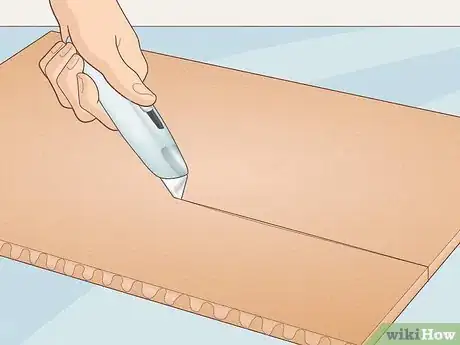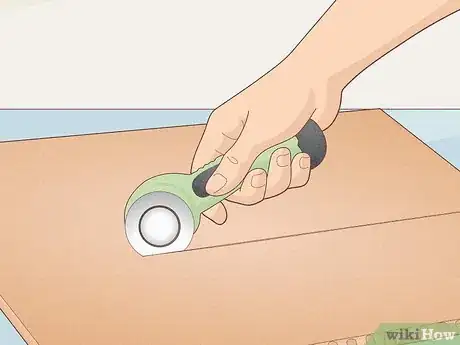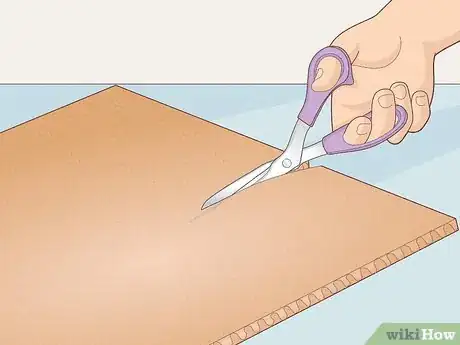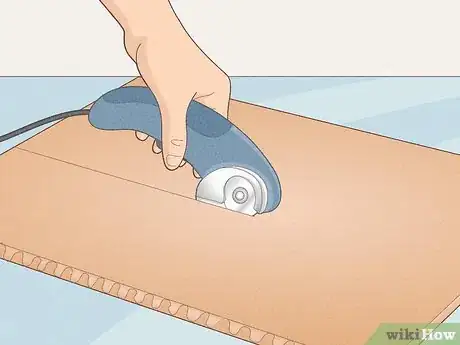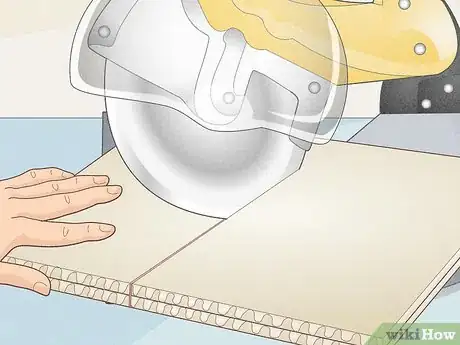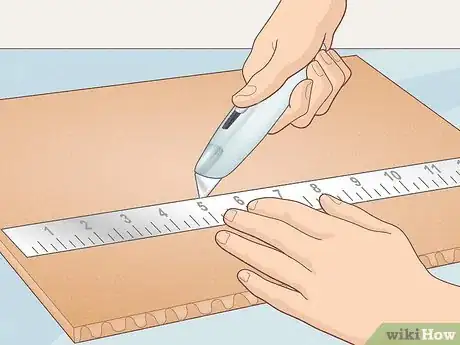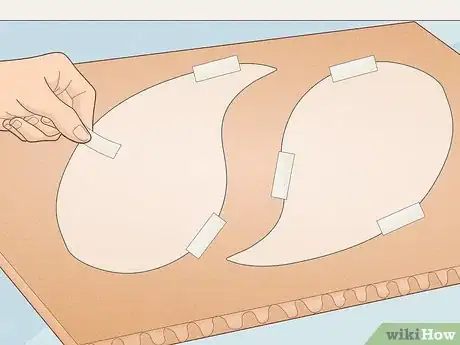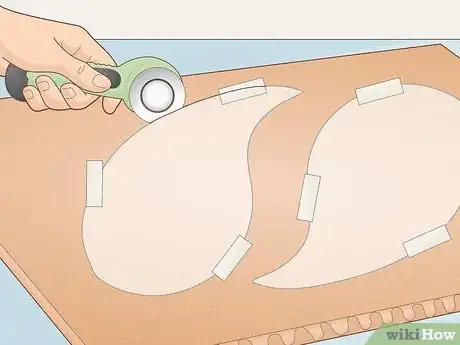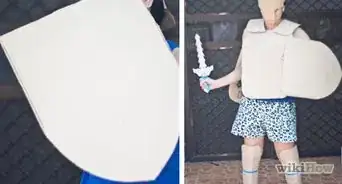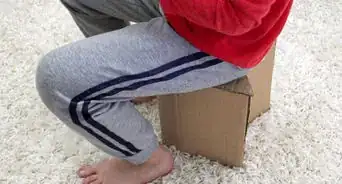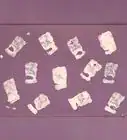This article was co-authored by wikiHow staff writer, Eric McClure. Eric McClure is an editing fellow at wikiHow where he has been editing, researching, and creating content since 2019. A former educator and poet, his work has appeared in Carcinogenic Poetry, Shot Glass Journal, Prairie Margins, and The Rusty Nail. His digital chapbook, The Internet, was also published in TL;DR Magazine. He was the winner of the Paul Carroll award for outstanding achievement in creative writing in 2014, and he was a featured reader at the Poetry Foundation’s Open Door Reading Series in 2015. Eric holds a BA in English from the University of Illinois at Chicago, and an MEd in secondary education from DePaul University.
There are 13 references cited in this article, which can be found at the bottom of the page.
This article has been viewed 47,922 times.
Learn more...
There are a variety of easy ways to cut thick cardboard. The odds are high that you have some of the tools you need stashed somewhere in your home right now. However, if you plan on cutting a lot of cardboard, you may want to invest in a specialized tool to make this process easier. While a utility knife or scissors will get the job done, something like a cardboard-cutting knife or electric rotary tool will really streamline this process in the future.
Steps
Common Tools
-
1Grab a utility knife or box cutter for a simple solution. Set the cardboard down on a cutting mat and brace it in place with your off-hand. Extend the blade on your utility knife or box cutter, and puncture the cardboard with the tip of your knife. Hold the blade at a 45-degree angle and drag it toward you using gentle pressure.[1]
- If it’s corrugated, you may need to cut through the same line 2-3 times to get all the way through it.
- The non-slip cutting mat protects your work surface from damage.
- Keep your off-hand at least 6 inches (15 cm) away from the blade while you cut.
-
2Opt for a rotary cutter to carve clean lines into your cardboard. Rotary cutters are typically used to cut fabric, but they’ll cut cardboard. Set your cardboard down on top of a non-slip mat and push the rotary cutter into the cardboard. Apply even pressure while you drag the rotary cutter’s blade in the direction you want to cut.[2]
- Like the utility knife, you must use a non-slip cutting mat if you use a rotary cutter.
- The rotary cutter is a great option if you want to cut curves.
- You may be able to use a pizza cutter if it has a really sharp edge.
Advertisement -
3Use scissors if you don’t have anything else laying around. Scissors aren’t ideal since it can be hard to cut through thicker cardboard and the blades will get dull. Still, you should be able to cut cardboard with a basic pair of scissors. Hold the cardboard up with your nondominant hand and open the blades around the edge of the cardboard. Close the handles to make your cut and repeat as needed.[3]
- If you have gardening or trimming shears at home, those might be a better option. It depends on how sharp the blades are, though.
- If you have a whetstone or honing rod, sharpen your scissor’s blades before cutting especially thick cardboard.
Specialized Tools
-
1Buy a cardboard-cutting knife to cut corrugated cardboard with ease. A cardboard-cutting knife is a round, serrated blade with softer teeth. It’s designed explicitly to make cutting thick cardboard easy. To use one, push the tip of the blade through the cardboard and then you move it back and forth like you’re cutting through a juicy steak. You’ll end up with a perfect cut every time![4]
- You may be able to find one of these in a craft store. You’ll probably need to buy it online, though.
- This is a great investment if you’re a teacher or you have kids. These cardboard-cutting knives are much safer than other options. They really are quite dull compared to a regular knife.[5]
-
2Use special cardboard-cutting scissors for another simple solution. There are cardboard-cutting scissors you can buy to chop your cardboard up. These scissors are curved and have a sharp blade to cut through cardboard with ease. You use these scissors the same way you’d use a normal pair; just open the blades around an exterior edge and close the handles together to cut your cardboard.[6]
- This is another great option if you’re going to have older kids cutting up some cardboard.
-
3Go for an electric rotary cutter to shred lots of cardboard quickly. Pick one of these up online or at a construction supply store. Release the safety valve on top of the cutter and press the large button on the grip to activate the cutting blade. Then, slowly slide the cardboard into the guide on the front of the rotary cutter and move it forward to cut the cardboard.[7]
- There’s a cutting guard that covers the majority of the blade, so these things are generally pretty safe.
- These cutters are also a great option if you regularly need to cut mesh, foam board, wrapping paper, or cardstock.
-
4Cut through extremely tough cardboard with a circular saw. If you’ve got some industrial-strength cardboard, you can use a circular saw to cut through it.[8] Place the cardboard on top of two sawhorses and secure it with clamps. Set your circular saw to the lowest cutting speed. Lift the blade guard up hold the guideline on the edge of your cut. Place both of your hands on top of the handle, and pull the trigger to slowly guide the saw forward. Let the momentum of the blade carry you through your cut.[9]
- You must wear a dust mask and protective eyewear if you’re using a circular saw, since the blade may send shards of cardboard flying into the air.
- You can also use a band saw, electric cutting knife, and table saw if you know how to use any of these tools.[10]
-
5Use a laser cutter to make precise cuts and engravings in cardboard. Laser cutters are expensive, but they may be a good investment if you’re cutting a lot of cardboard for work.[11] To use one, lay your cardboard flat in the cutting bed. Then, enter the dimensions or design in the drawing software connected to the cutter. Adjust the laser cutter’s settings for cardboard and let it cut through the material for you![12]
- Laser cutters typically have different settings for metal, wood, cork, plastic, and other materials. Make sure you change the settings so the laser is set for cardboard if you want crisp lines.
- Many universities have laser cutters for students to use under the supervision of professor.
How to Make Cutting Easier
-
1Use a metal ruler as a straight edge for clean, straight cuts. If you want a perfectly straight cut, grab a metal ruler and line it up along your cutting line. Drag your utility knife along the ruler, or hold the cardboard over the edge of a table and carefully guide your scissor blades along the edge. You can also use a metal ruler as a guideline for a circular saw, cardboard-knife, or rotary tool.[13]
- You shouldn’t use wood or plastic as a straight edge. If your cutting tool catches on a non-metal object, it may cut through it.
-
2Tape stencils to your cardboard if you’re cutting out a specific shape. You can draw directly on cardboard to cut out a specific shape, but it’s a lot easier to simply tape a stencil directly on your cardboard. Attach the stencil with see-through masking tape and use the edge of the stencil as your guide. Cut carefully around the exterior edge of the stencil and carefully remove it when you’re done.[14]
- Don’t press the tape down super hard if you don’t want it to peel up some of the cardboard when you take it off.
-
3Use short strokes with a utility knife or rotary cutter to cut curves. Sketch out the line you’d like to cut. Then, grab a sharp utility knife or rotary cutter. Hold the blade straight against the start of your cut and slowly drag it along the line you drew. Work slowly and pause every time the line curves to reorient the knife or cutter. By cutting each portion of the curve in separate strokes, you’ll keep the blade from slipping and ensure that your cut looks seamless![15]
- You can use a drawing compass to sketch out perfect circles. Alternatively, you can also trace a bottle cap or some other round object.
-
4Lay a weight down on top of the cardboard to prevent fraying. The more pressure you have on the cardboard, the less likely it will be to split or slide around. Grab some barbell weights, paper weights, or bricks and lay them down along the sides of your cutting line. This will make it much easier to cut through the cardboard.[16]
- You can’t do this if you’re using a circular saw or electric rotary tool, but the good news is that you really don’t need to. Those tools won’t need any help getting through the cardboard.
-
5Score your cardboard with a dull edge to bend it instead of cutting. If you just want to bend the cardboard, lay a metal ruler down along the edge you want to bend and grab a dull knife. Apply light pressure and drag the tip of the knife or spoon along the ruler to compress the cardboard down a little. Then, remove your ruler and bend the cardboard by hand. It’ll have no problem bending along the line you just scored![17]
- You can try cutting halfway through cardboard with a utility knife to score it, but that can be kind of tricky to do without cutting all the way through the material on accident.
Warnings
- If you’re using a power tool, keep your hands away from the cutting blade. Wear a dust mask and protective eyewear to stay safe while you’re operating the tool.[18]⧼thumbs_response⧽
- Scissors will get increasingly more difficult to use with each piece of cardboard you cut. The blades will just keep getting duller and duller. It’s fine to use basic scissors if you’re just cutting up a few strips, but it isn’t an effective way to get through a lot of cardboard.[19]⧼thumbs_response⧽
Things You’ll Need
Common Tools
- Utility knife or box cutter
- Rotary tool
- Scissors
- Non-slip cutting mat
Specialized Tools
- Cardboard-cutting scissors
- Electric rotary tool
- Cardboard-cutting scissors
- Circular saw or other power saw
- Sawhorses
- Dust mask
- Protective eyewear
- Laser cutter
How to Make Cutting Easier
- Metal ruler
- Weights
- Tape
- Stencils
- Spoon or knife
References
- ↑ https://toolspeek.com/how-to-cut-cardboard/
- ↑ https://learn.adafruit.com/cardboard-fundamentals/cutting-tools-and-techniques
- ↑ https://learn.adafruit.com/cardboard-fundamentals/cutting-tools-and-techniques
- ↑ https://youtu.be/5ICQvZ_0l10?t=34
- ↑ https://youtu.be/4ukNTRpueVY?t=274
- ↑ https://youtu.be/ssCAJUJZnUA?t=64
- ↑ https://youtu.be/4ukNTRpueVY?t=646
- ↑ https://toolspeek.com/how-to-cut-cardboard/
- ↑ https://www.popularmechanics.com/home/tools/a9183/circular-saw-tips/
- ↑ https://toolspeek.com/how-to-cut-cardboard/
- ↑ https://toolspeek.com/how-to-cut-cardboard/
- ↑ https://wikis.utexas.edu/display/SOAdigitech/How+to+Use+the+Laser+Cutter
- ↑ https://learn.adafruit.com/cardboard-fundamentals/cutting-tools-and-techniques
- ↑ https://youtu.be/NW7UvCVoO1Q?t=24
- ↑ https://youtu.be/pMpqhFZ4Kvg?t=15
- ↑ https://youtu.be/ylWZJIWT-vs?t=189
- ↑ https://youtu.be/aMLtQtgOeQc?t=31
- ↑ https://www.osha.gov/Publications/osha3080.html
- ↑ https://learn.adafruit.com/cardboard-fundamentals/cutting-tools-and-techniques
